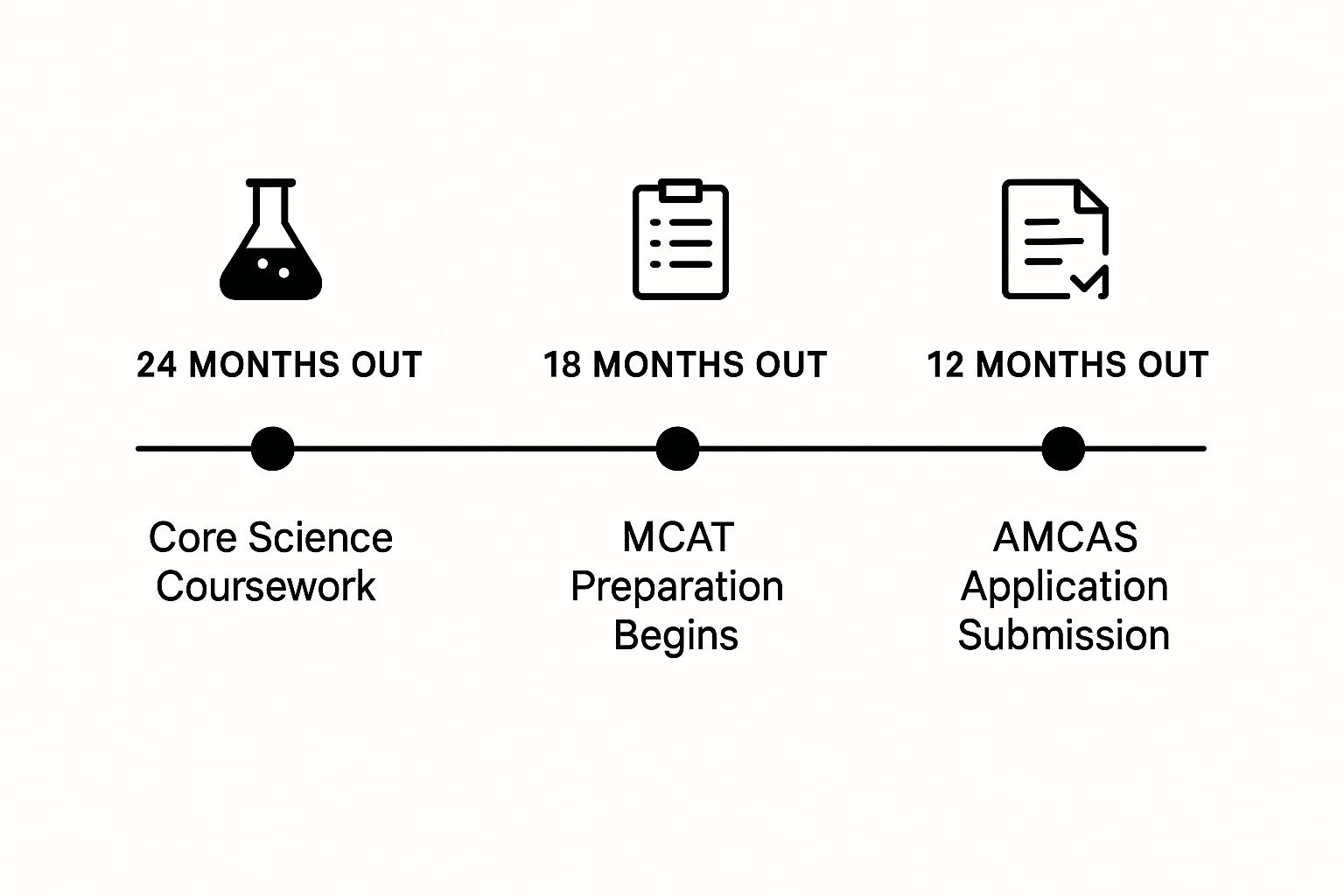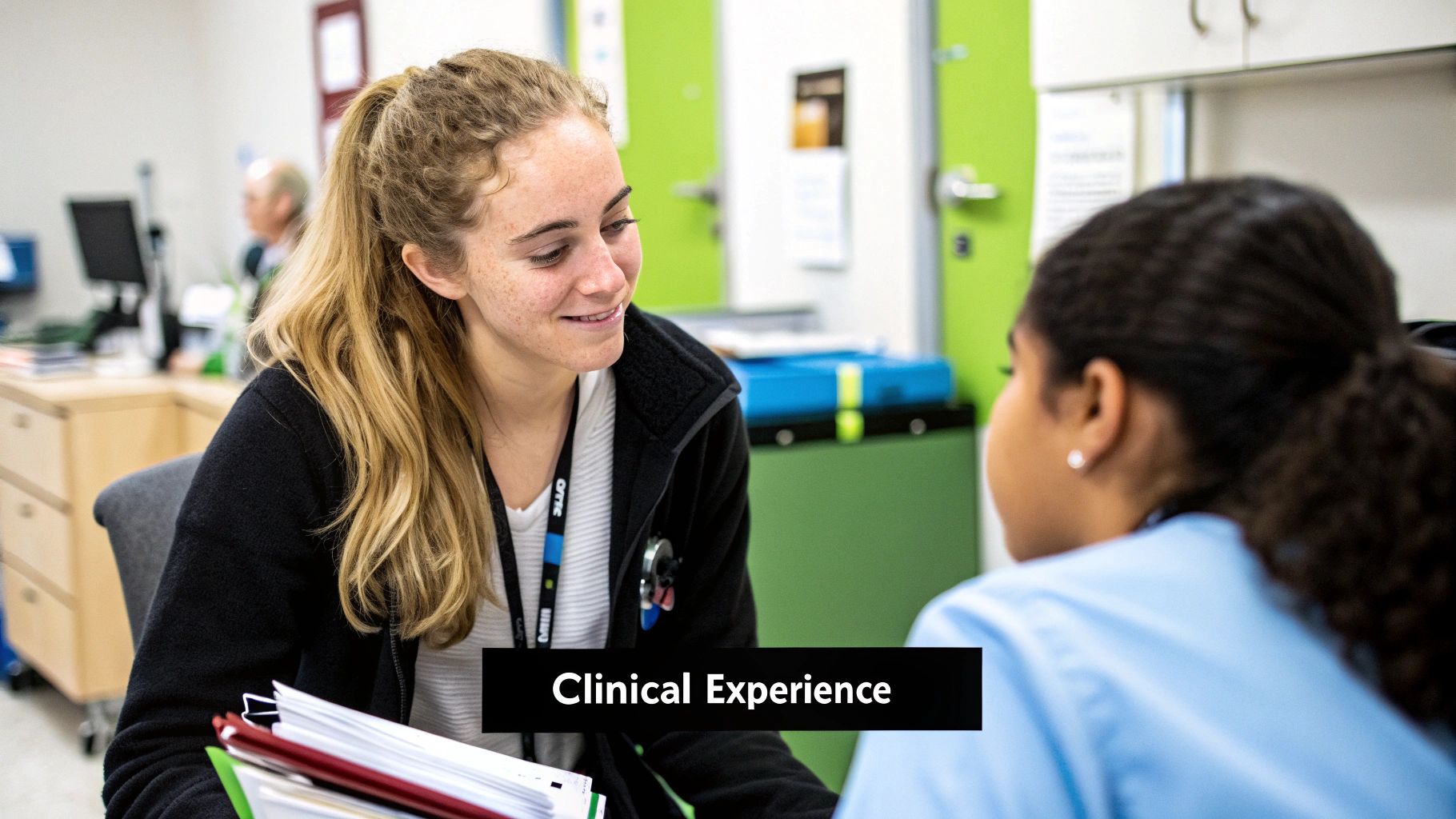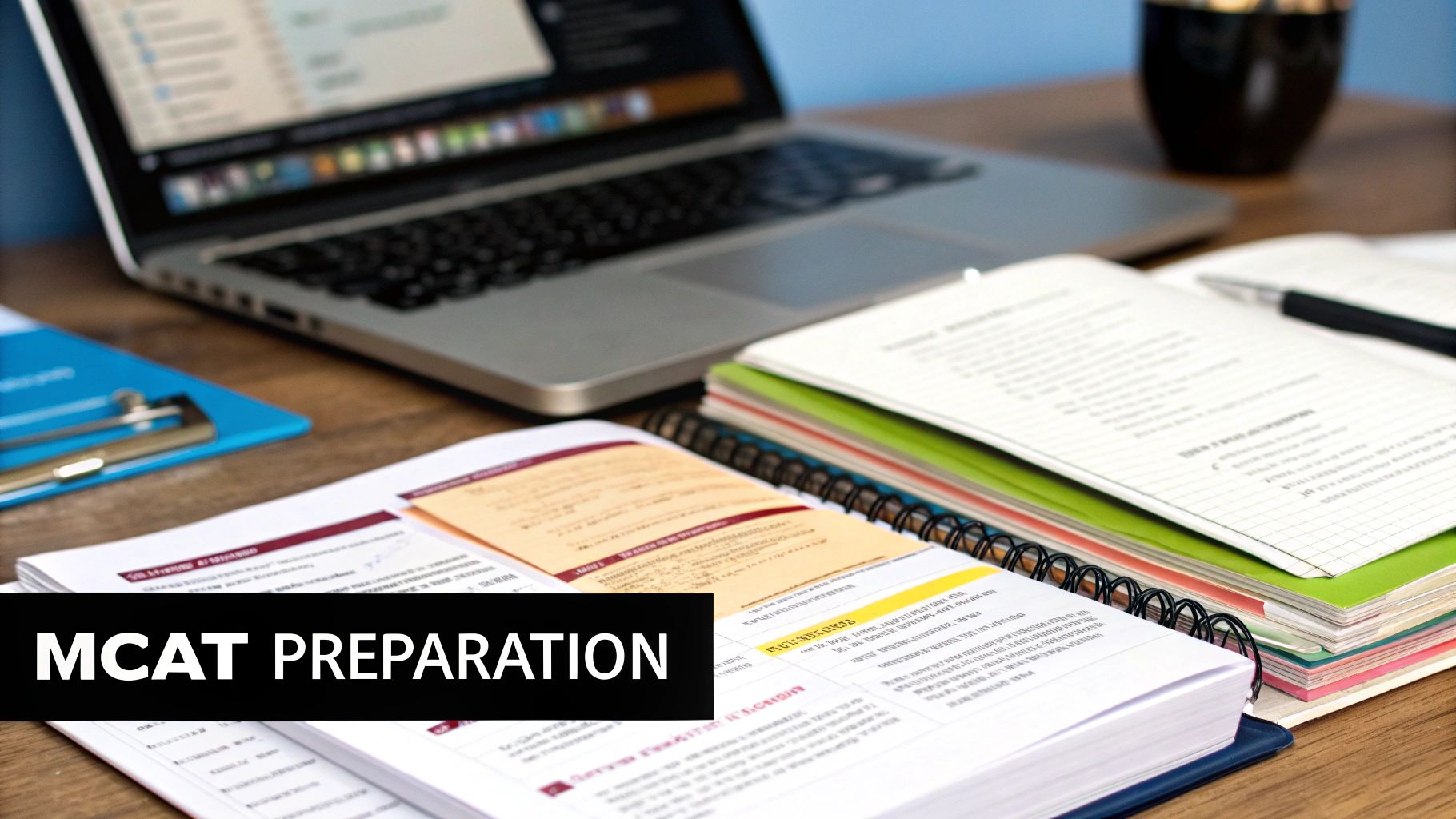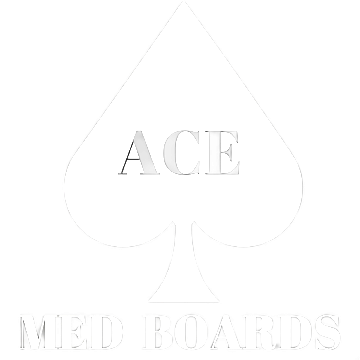Getting into medical school is a serious commitment. It’s a marathon built on four key things: stellar grades, a strong MCAT score, meaningful hands-on experience, and a compelling story that ties it all together. This isn't something you can cram for; it requires a steady, strategic effort from your very first day of undergrad.
Your Medical School Journey Starts Here
The path to becoming a doctor is tough, no doubt about it. But with a clear strategy, it's absolutely achievable. This guide is designed to cut through the noise and give you a real-world roadmap, focusing on what admissions committees actually care about. We’ll tackle the common anxieties head-on and give you a realistic, encouraging look at what it takes to build a standout application.
Understanding the Competitive Landscape
Let's be honest: the journey is more competitive than ever. Over the last decade, the number of applicants has climbed from 49,480 in the 2014–2015 cycle to 52,577 in 2023–2024. But here's the good news—the percentage of applicants who actually matriculated also rose from 41.1% to 44% in that same period.
What does that tell us? While the applicant pool is bigger, more qualified candidates are getting in. This just highlights the need to build a distinct and well-rounded application that goes way beyond just good grades.
As you plan your path, it's also smart to keep an eye on how technology is changing the field. For instance, innovations like voice recognition software for healthcare are changing how doctors work, making patient care more efficient.
A successful application is a narrative. It tells the story of who you are, why you are committed to medicine, and how your unique experiences have prepared you for the rigors of medical school and a life of service.
Visualizing Your Pre-Med Timeline
Mapping out your preparation is the best way to stay on track without getting completely overwhelmed. Think of your undergrad years as a series of strategic phases, with each one building toward the ultimate goal: submitting your application.
This timeline gives you a bird's-eye view of the major milestones you should be hitting in the two years leading up to your application.

As you can see, this all starts early. Foundational coursework begins two years out, dedicated MCAT prep kicks in around the 18-month mark, and the final application push happens a full year before you hope to matriculate. By breaking it down like this, you can focus on one stage at a time and make the whole process feel much more manageable.
Pre-Med Preparation Timeline At a Glance
To give you an even clearer picture, here’s a table that breaks down the key goals for each year of your undergraduate journey. Use this as a guide to make sure you're staying on track.
| Undergraduate Year | Academic Focus | Extracurricular Priority | Application Task |
|---|---|---|---|
| Freshman Year | Excel in foundational science courses (Bio, Chem). Establish a strong GPA from the start. | Explore different clubs and volunteer opportunities to find your passions. | Begin building relationships with professors and potential mentors. |
| Sophomore Year | Complete core pre-reqs (Orgo, Physics). Consider a research position. | Seek leadership roles in one or two key activities. Find consistent clinical volunteering. | Start thinking about your personal story. Why medicine? |
| Junior Year | Take advanced science electives. Begin dedicated MCAT preparation (spring semester). | Deepen involvement in your core activities. Consider a significant research or clinical project. | Request letters of recommendation. Draft your personal statement. |
| Senior Year | Maintain a high GPA. If taking a gap year, plan meaningful experiences. | Continue your key activities, demonstrating long-term commitment. | Submit primary (AMCAS) and secondary applications. Prepare for interviews. |
Think of this timeline not as a rigid set of rules, but as a flexible framework. The key is consistent effort and thoughtful planning, ensuring that by the time you hit "submit," you've built an application that truly reflects your potential as a future physician.
Building Your Academic Foundation

Let's be blunt: your GPA and the courses you take are the absolute bedrock of your medical school application. While a high GPA is a non-negotiable, admissions committees are digging deeper. They're looking for a story of intellectual curiosity, resilience, and a genuine drive to master the sciences.
Think of your transcript as the opening chapter of your story. It sets the stage for everything else—your MCAT score, your letters of recommendation, and your personal statement. This foundation is built on two things: nailing the required science courses and strategically picking advanced electives that show you're not just checking boxes. It’s about proving you can handle the brutal pace of medical school while also showing you're a proactive, engaged learner.
Mastering Your Coursework Strategically
Every single premed student has to complete a core set of science courses. These aren't just hurdles to clear; they're the fundamental language of medicine. You have to excel in them. Period.
- Core Sciences: Your journey kicks off with a full year of biology, general chemistry, organic chemistry, and physics—all with their corresponding labs.
- Essential Skills: A year of English is also required to sharpen your communication skills, which are surprisingly critical. On top of that, most schools now either require or strongly recommend biochemistry and psychology.
But the basics are just the starting line. The advanced electives you choose are where you can really start to stand out. Taking on tough courses like genetics, immunology, microbiology, and anatomy does two things: it gives you a massive leg up for the MCAT and signals to adcoms that you're willing to go beyond the bare minimum.
For a complete rundown, make sure you explore the full list of https://acemedboards.com/prerequisites-for-medical-school/ to ensure your academic plan is rock-solid.
Your academic record needs to tell a story of consistent effort and growth. A single bad grade won't torpedo your application, but a pattern of academic struggle is a major red flag. The key is showing you can identify a weakness and then actively work to fix it.
Cultivating Strong Professor Relationships
Powerful letters of recommendation come from genuine relationships, not last-minute, desperate emails. These letters are the admissions committee's chance to get a third-person perspective on your character, work ethic, and intellectual spark. You need to start building these connections from day one.
Don't just be another face in a 300-person lecture hall. Make a point to go to office hours. Ask smart, thoughtful questions after class. Show some real interest in your professor's research or their career path. This is how they get to know you as a person, not just a student ID number on their roster.
When you're ready to ask for a letter, do it in person and come prepared with a "brag packet." This isn't arrogant; it's professional and makes their job infinitely easier.
Your packet should include:
- Your resume or CV.
- A draft of your personal statement.
- A list of the schools you're applying to, complete with deadlines.
- A short summary of your goals and why you're so set on medicine.
This simple preparation helps them write a letter that's detailed, personal, and far more impactful than a generic template.
Navigating Academic Setbacks
Getting a C in organic chemistry can feel like the end of the world. It’s not. What truly matters to an admissions committee is how you respond to that stumble.
If you get a poor grade, you have to demonstrate growth. You could retake the course, but an even better move is to crush a higher-level course in the same subject. You can also address it head-on (but briefly and professionally) in your application. For example, explain how that tough experience forced you to develop better study habits, which you can then prove with a clear upward trend in your subsequent grades.
For students with a more significant pattern of low grades, or for those making a career change, a post-baccalaureate or Special Master's Program (SMP) can be a game-changer. These programs are designed to show a recent, dedicated commitment to handling a rigorous science curriculum. If you simply need to build up that science foundation from scratch, resources like this guide on Access to Higher Education in Biology can also offer a clear, structured path forward.
Developing a Winning MCAT Strategy

The Medical College Admission Test (MCAT) is the big one. It's often seen as the single biggest hurdle on the path to medical school, and honestly, that reputation is well-earned. This exam is a marathon, built to test not just what you've memorized, but how you think, reason, and solve complex problems under serious pressure.
For many, this is the 'make-or-break' test. To give you some perspective, the average MCAT score for students who actually got into U.S. MD programs in 2024 was a 511.7. Anything below a 509 is often considered a long shot, which is why most premeds block off 300 or more hours for dedicated prep time.
But here’s the secret: success isn't about brute-force memorization. It’s about having a smart, adaptable strategy. You need to understand the test's structure inside and out, pick the right study method for your brain, and simulate test day until it feels like second nature.
Choosing Your Study Method
Your first big decision is figuring out how you're going to tackle this beast. There’s no single right answer here—the best approach depends entirely on your self-discipline, budget, and how you learn best.
- Self-Study: This is the most flexible and wallet-friendly route. You’re the captain of your own ship, building a curriculum from top-tier resources like AAMC official materials, UWorld for its legendary question bank, and Anki for spaced repetition. This path demands serious discipline but gives you total control.
- Structured Prep Courses: If you thrive with deadlines and external accountability, a structured course from a company like Kaplan or The Princeton Review might be a good fit. They offer a set schedule, live instruction, and a ton of proprietary materials, but they do come with a hefty price tag.
- One-on-One Tutoring: For those who are struggling with specific content areas or need targeted strategy help, a private tutor can be a game-changer. It's the most expensive option, but the personalized feedback and tailored strategies are often worth it.
For a deeper dive into building out your study plan, our complete guide on how to prepare for the MCAT is packed with more specific tips and resource recommendations.
A critical mistake so many students make is underestimating the psychological side of the MCAT. Building mental stamina and a confident mindset is just as important as mastering biochemistry pathways or physics formulas.
Deconstructing the MCAT Sections
The MCAT is way more than just a science test. It's broken into four distinct sections, and each one demands a slightly different game plan.
- Chemical and Physical Foundations of Biological Systems (Chem/Phys): This section is a mash-up of general chemistry, o-chem, physics, and biochemistry. The key here is being able to recall formulas quickly and apply them to complex, often biology-focused, passages. Timed practice is your absolute best friend for Chem/Phys.
- Critical Analysis and Reasoning Skills (CARS): For many, this is the most dreaded section. CARS throws dense passages on topics from philosophy to art history at you and tests your ability to answer questions based only on the text provided. No prior knowledge is needed—it's pure critical reasoning. Daily practice is non-negotiable if you want to improve.
- Biological and Biochemical Foundations of Living Systems (Bio/Biochem): This is the beast of content, covering everything from molecular genetics to organ systems. The trick isn't just knowing the facts, but integrating concepts and understanding how different biological systems talk to each other.
- Psychological, Social, and Biological Foundations of Behavior (Psych/Soc): As the newest section, this one tests introductory psychology, sociology, and the biological basis of behavior. A strong vocabulary and a solid understanding of experimental design are crucial for success here.
The Power of Practice Exams
Full-length practice exams are the absolute cornerstone of any good MCAT plan. Think of them not just as tests, but as your training ground for building the endurance and mental focus you'll need on the real day.
You should plan to take a full-length practice test under realistic conditions—timed, with the proper breaks—at least once every one to two weeks. The real magic, though, happens after the test is done.
Effective Practice Test Analysis
| Analysis Step | Actionable Task | Goal |
|---|---|---|
| Review Every Question | Go through every single question, right and wrong. Don't just glance at the right answer and move on. | Understand why the right answer is right and, just as importantly, why the wrong choices are tempting but incorrect. |
| Categorize Your Mistakes | Sort your errors. Was it a content gap? Did you misread the question? A reasoning error? Or just a silly mistake? | Identify patterns. Are you consistently missing questions on a specific topic or a certain type of question? |
| Create a Mistake Log | Keep a simple spreadsheet or notebook. For each error, log the question, why you missed it, and what you'll do to fix it. | Turn your mistakes into a concrete study plan. This transforms your review from passive to active learning. |
By meticulously breaking down your performance, you can stop studying aimlessly and start focusing on the high-yield areas where you can gain the most points. This data-driven approach ensures that when test day finally arrives, you’re not just hoping for the best—you’re fully prepared to perform at your peak.
Gaining Meaningful Clinical and Research Experience

Let's be blunt: admissions committees need to see that your dream of becoming a doctor is more than just a nice idea. They want proof that you've dipped your toes into the real world of medicine, seen the messy and challenging parts of patient care, and still want in.
Meaningful clinical and research experiences are how you provide that proof. This isn't just about checking boxes to fill up your AMCAS application. Think quality over quantity. Adcoms are far more impressed by a long-term commitment to one or two roles than a dozen superficial, short-term gigs. Deep engagement shows maturity, dedication, and a genuine desire to learn.
The Pillars of a Strong Pre-Med Profile
Your experiences should generally fall into three core categories. Each one gives you a different, crucial perspective on the world of medicine.
- Clinical Exposure: This is your direct, unfiltered view into patient care. It's where you find out if the day-to-day reality of being a doctor is what you truly envision.
- Research Experience: This shows you understand the science behind the medicine. It demonstrates critical thinking and a curiosity that goes beyond the textbook.
- Community Service: This speaks to your character. It’s about showing a commitment to serving others—a fundamental part of being a physician. It proves you care about people, not just the science.
The best applications don't just list these activities; they weave them into a compelling story. Imagine volunteering at a free clinic (community service + clinical exposure) and becoming fascinated by the health disparities you witness. That experience could directly lead you to join a research lab studying the social determinants of health in that very community. See how it connects?
How to Find High-Impact Clinical Opportunities
Getting direct exposure to patients is non-negotiable. This is where you move from the classroom to the clinic and see what medicine actually looks and feels like. Shadowing a doctor is a decent start, but admissions committees really value roles where you have hands-on responsibilities.
Here are a few high-impact roles to consider:
- Medical Scribe: You'll work shoulder-to-shoulder with physicians, documenting patient encounters in real time. It's an incredible front-row seat to clinical reasoning, medical jargon, and the doctor-patient relationship.
- EMT or CNA (Certified Nursing Assistant): These roles throw you right onto the front lines of patient care. The experience you'll gain managing difficult situations and providing direct, hands-on support is absolutely invaluable.
- Hospital Volunteer (with patient contact): Look for roles that get you interacting with patients. Forget just delivering flowers. Try to get a position in the ER, patient transport, or as a hospice volunteer where you can have real conversations and offer comfort.
Here’s a pro tip: Don't just show up and go through the motions. Be engaged. Ask thoughtful questions when it's appropriate, and keep a journal to reflect on what you're seeing. What did you learn about empathy? Communication? The healthcare system? This reflection is the raw material for your personal statement and interview answers.
Getting Your Foot in the Door of a Research Lab
Jumping into research can feel intimidating, but it’s more doable than most pre-meds think. It’s your chance to see how discoveries in the lab eventually make their way to the patient's bedside.
Your first step is to start browsing the faculty websites of the science departments at your university. Find professors whose work genuinely sparks your interest. Don’t just look for the biggest names; look for projects you find fascinating.
A Simple Guide to Cold-Emailing Professors
| Step | Your Action | Why It's a Game-Changer |
|---|---|---|
| Do Your Homework | Read a couple of the professor’s recent papers. Get a real sense of what their lab is trying to achieve. | This proves you have a genuine interest and aren't just blasting out a generic email to every professor on campus. |
| Write a Killer Email | Keep it short and professional. Mention a specific paper you read and briefly connect it to your own interests or coursework. Attach your resume. | A personalized touch makes your email stand out from the dozens of "Dear Professor, I need research" emails they get every week. |
| Follow Up (Politely) | If you don’t get a reply in a week or two, send a brief, polite follow-up email. | Professors are incredibly busy. Your original email might have just gotten buried. A gentle nudge is perfectly fine and shows persistence. |
Even if your first research gig isn't in a world-famous lab, any experience is good experience. You’ll learn how to think like a scientist, analyze data, and appreciate the patience that scientific progress demands—all skills that will make you a better physician. Building out this portfolio is a critical piece of the puzzle for how to prepare for medical school.
Crafting Your Personal Statement and Application
After years of grueling science courses, late-night study sessions, and meaningful volunteer work, the application is where it all finally comes together. This is your chance to transform from a list of stats and activities into a three-dimensional person with a story to tell. Your application isn't just a record of what you did; it's a narrative about why you did it.
The primary application goes through centralized services like AMCAS (for MD programs), AACOMAS (for DO programs), or TMDSAS (for Texas medical schools). Each one asks you to meticulously detail your academic history, experiences, and, most importantly, share your personal statement. This is your moment to connect the dots for the admissions committee.
The Personal Statement: Your Core Narrative
Your personal statement is the absolute heart of your application. It’s a 5,300-character essay that must answer one fundamental question: Why do you want to be a doctor?
The trick is to show, not just tell. Instead of saying you're compassionate, describe a specific patient interaction that truly tested and then solidified your empathy. Think of it this way: your experiences are the "what," but your reflection on them is the "so what."
For example, anyone can write about their research on neurodegenerative diseases. A powerful statement, however, connects that lab work to a personal experience—maybe with a grandparent who had Alzheimer's—and reflects on how the methodical, often frustrating, process of research fueled a desire to bridge the gap between scientific discovery and patient care.
A memorable personal statement isn't a laundry list of achievements. It's a reflective, authentic story that reveals your character, motivations, and resilience. It should leave the reader feeling like they know you and can genuinely envision you as a future physician.
Crafting a narrative that is both personal and professional is a huge challenge. For a deeper dive, our guide on how to write a personal statement offers targeted advice and real examples to help you build a story that resonates.
Transforming Activities into Impact Stories
The "Work and Activities" section of the AMCAS application gives you space to list up to 15 experiences. But here's the crucial part: it allows you to select up to three as your "most meaningful." This is where you provide the backstory, explaining why an experience had such a profound impact on your journey.
This is a golden opportunity to highlight your growth. Don't just describe your duties as a medical scribe. Explain how documenting thousands of patient encounters taught you the art of clinical reasoning and the critical importance of precise communication. Frame your activities not as tasks you completed, but as transformative experiences that shaped your entire perspective.
Conquering the Secondary Application Tsunami
Shortly after you hit "submit" on your primary application, the secondary applications will start rolling in. This can feel like a tsunami. These are school-specific essays designed to see if you're a good fit for their unique mission and program. It's easy to get overwhelmed, as you might receive dozens of these requests in a very short time.
The key to managing secondaries is efficiency without sacrificing quality. Pre-writing is your best friend. A lot of schools ask similar questions, so you can prepare core essays on common topics ahead of time.
Common Secondary Prompts to Prepare For:
- "Why are you interested in our medical school specifically?"
- "How will you contribute to the diversity of our class?"
- "Describe a time you faced a significant challenge or failure."
Create thoughtful, detailed drafts for these themes. When a secondary application lands in your inbox, you can then adapt your core essay to fit that school, weaving in specific details about their unique curriculum, research opportunities, or community service programs. This strategy lets you submit high-quality, personalized responses quickly—a crucial advantage in the rolling admissions game.
Excelling in Your Medical School Interviews
An interview invitation is a massive win. Seriously, take a moment to celebrate. It means the admissions committee looked at your application—your stats, your essays, your experiences—and thought, "This person has what it takes." Now, it's time to seal the deal.
This final stage is where you prove you're the thoughtful, empathetic, and resilient future doctor they're looking for. It can feel intimidating, but remember why they invited you: they want to meet the person behind the paper. They want to hear your story, understand what drives you, and see how you think on your feet. It's also your chance to interview them and see if the school is truly the right place for you.
Understanding Different Interview Formats
Medical schools use a few different interview styles, and knowing what’s coming is half the battle. You'll most likely run into one of these two formats.
Traditional Interview: Think of this as a focused conversation. It's usually one-on-one or with a small panel and lasts anywhere from 30 to 60 minutes. This is your chance to connect on a personal level, dive deep into your journey, and explain exactly why you’re interested in their specific program. The goal here is to build genuine rapport.
Multiple Mini-Interview (MMI): The MMI is a different beast entirely. It’s a circuit of short, timed stations, each presenting a unique scenario. You might face an ethical dilemma, a teamwork challenge, or even a role-playing exercise with an actor. The MMI is designed to see your problem-solving, ethical reasoning, and communication skills in action, all under a bit of pressure.
No matter the format, the core of your preparation is the same. You have to know your application cold. Be ready to talk about every single experience you listed with depth, reflection, and passion.
Preparing Your Core Interview Responses
You can't predict every question, but you can absolutely prepare for the big ones. The goal isn't to have a memorized script—adcoms can spot that a mile away. Instead, develop thoughtful talking points that you can adapt to almost any question that comes your way.
Three Essential Questions to Master:
"Why do you want to be a doctor?" This is the big one. Your answer needs to be a compelling story, not just a list of clichés. Try weaving together a personal experience that sparked your interest, a clinical moment that solidified it, and a service activity that showed you the kind of impact you want to make. Show them how your commitment has grown over time.
"Tell me about yourself." This isn't an invitation to recite your resume. It's your opportunity to frame your narrative. Pick 2-3 key themes or experiences that define your path to medicine and structure your answer around them. It should be a concise story that leads right up to why you're sitting in that chair today.
"Why our medical school?" This is where your research shines. Go way beyond the mission statement on their homepage. Talk about a specific professor's research you admire, a unique clinical program they offer, or a community outreach initiative that genuinely excites you. Show them you've done your homework and can see yourself thriving there.
Your interview is where your entire application comes to life. All the late-night study sessions, the meaningful volunteer hours, and your personal growth finally get a voice. Be authentic, be reflective, and let your genuine enthusiasm for medicine shine through. That’s what will leave a lasting impression.
Common Questions From Pre-Meds
If you're on the path to medical school, you've probably got a million questions swirling around. Getting straight, honest answers can be tough, but it's the key to focusing your energy where it actually counts. Let's tackle some of the most common uncertainties I see from aspiring doctors.
One of the biggest anxieties revolves around clinical hours. Is there a magic number? Not exactly, but successful applicants typically have at least 100-150 hours of solid clinical experience. The real secret here is quality over quantity. Admissions committees are far more impressed by a long-term commitment where you had real patient interaction than they are by a long list of passive shadowing gigs.
Gap Years and The Biggest Pre-Med Mistake
Another hot topic is the gap year. A lot of students worry that taking time off looks bad, but that couldn’t be further from the truth. In fact, taking a gap year is becoming more and more common, and admissions committees often see it as a huge plus.
A gap year is your chance to get serious work or volunteer experience, beef up your application, and study for the MCAT without the pressure of a full course load. As long as you use that time wisely, it can seriously boost your chances.
So, what's the single biggest mistake I see pre-meds make? It's getting tunnel vision on grades and MCAT scores while completely forgetting about personal growth and meaningful experiences.
Admissions committees aren't just looking for robots who can ace exams. They want to see future doctors who have empathy, resilience, and a genuine desire to serve others. If you neglect to build these qualities through your extracurriculars, you'll end up with an application that's technically strong but totally forgettable. The goal is to show them you're not just a great student, but a well-rounded person ready for the human side of medicine. Your story matters just as much as your stats.
At Ace Med Boards, we know every part of the pre-med journey has its own hurdles. From MCAT prep to application consulting, our expert tutors offer the personalized guidance you need to build a compelling application. Start your path to acceptance with a free consultation today.
